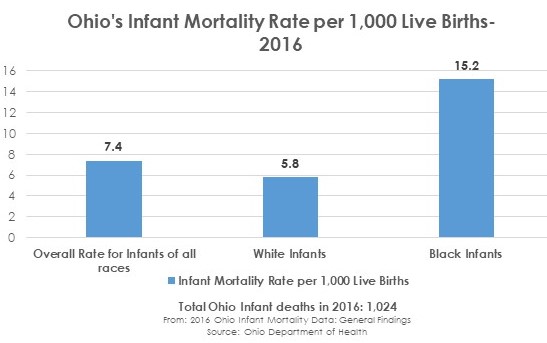Overview
Infant mortality is the death of an infant before his or her first birthday. The infant mortality rate is the number of infant deaths for every 1,000 live births. Each year in Franklin County, approximately 150 babies die before their first birthday.
What is Infant Mortality?
Infant mortality is the death of a live-born infant before their first birthday. The infant mortality rate is the number of infant deaths for every 1,000 live births.
Why is Infant Mortality Important?
Infant mortality represents a long-standing concern of public health. The infant mortality rate is not only seen as a measure of the risk of infant death but it is used more broadly as an indicator of:
Community Health Status
Community Poverty and Economic Status
Availability and Quality of Health Services
Causes
Many factors can cause infant mortality. Race, age and health of the mother are all major factors but others also play a role in infant mortality.
Most babies 28 days and younger die as a result of:
- Birth defects
- Preterm birth/prematurity (birth before 37 weeks gestation) and low birth weight
- Pregnancy complications
- Maternal health conditions
- Lack of access to appropriate care
Most babies 28 days to one year old die as a result of:
- Sudden Infant Death Syndrome (SIDS)
- Injuries (e.g., suffocation)
- Infection
Since 2013, pre-term birth/prematurity has remained the leading cause of newborn illness and mortality and suffocation has been the leading cause of injury-related death for babies before their first birthday.
Ohio’s Infant Mortality Rate
In 2016, there was 1.9 percent increase in infant deaths compared to 2015. 1,024 Ohio infants died before their first birthday in 2016 compared to 1,005 in 2015. The 2016 data indicates a slight increase in the overall infant mortality rate from 7.2 infant deaths per 1,000 live births in 2015 to 7.4 in 2016. Mortality rates for both black and white infants in Ohio have also increased from 2015 to 2016.
- 2016 Ohio white Infant Mortality Rate: 5.8
- 2016 Ohio black infant Mortality Rate: 15.2
Although the overall infant mortality rate has increased, the 2016 data revealed that sleep-related deaths have trended downward. In Franklin County, infant mortality is primarily driven by premature births, low birth weight and unsafe sleep conditions.
What Can Be Done to Prevent Infant Mortality?
Every baby deserves to live past their first birthday. Infant mortality affects all of us in our communities but there are prevention methods that can be taken to help prevent infant mortality. A women’s health is the most important factor in preventing infant mortality. It is important for all women of reproductive age to adopt healthy behaviors such as:
- Taking folic acid
- Maintaining a healthy diet and weight
- Being physically active regularly
- Quitting tobacco use and avoiding second-hand smoke
- Not drinking excessive amounts of alcohol and using “street” drugs before pregnancy and not drinking or using “street” drugs at all during pregnancy
- Visiting your health care provider for regular check-ups, screenings and proper health care management especially if you’re considering becoming pregnant
- Talking with your health care provider about your options for delaying or avoiding pregnancy.
Infant mortality prevention is more than proper health care for the mother and baby during pregnancy. Once the baby is born, proper care after birth is needed to ensure the baby stays safe. Such after birth care includes:
Are you in need of a safe sleep surface for your baby? Contact our office at (614) 525-5960 or email us.
What Is Being Done in Ohio to Prevent Infant Mortality?
Over the past five years, Ohio’s lawmakers, in collaboration with Ohio’s county & city public health departments implemented various initiatives to address infant mortality. These include:
- Home visits
- Smoking cessation programs
- Breastfeeding resources
- Injury-prevention programs
- Partnering with county and city organizations (e.g. community centers, churches/faith-based organizations and foodbanks) to ensure women have access to services they may need.
For more information on what’s being done in Ohio to prevent infant mortality, click here.

